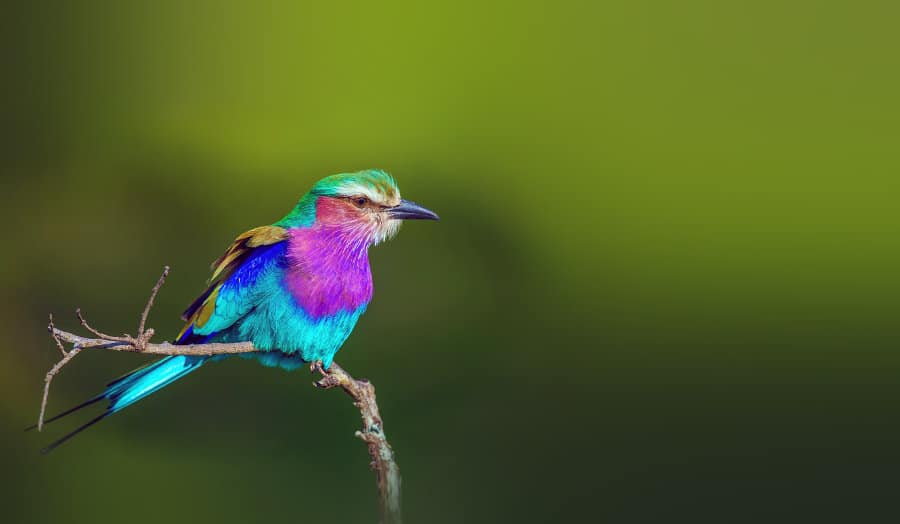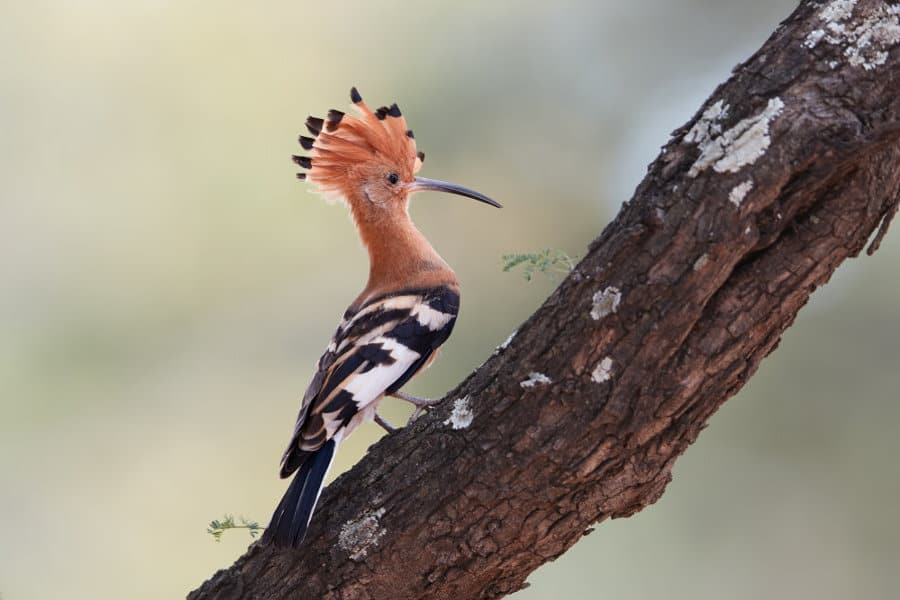The southern ground hornbill is a beloved bird species indigenous to Africa. It’s one of only two African ground hornbill species, the other being the Abyssinian ground hornbill.
It is also the largest of all hornbills in the world and regarded as one of the ‘Big Six’ birds to see in southern Africa. Ground hornbills are actually quite common in most of the region, especially the Kruger National Park.
However, that simple description doesn’t do our hornbill justice. Some aspects of the southern ground hornbill’s life and behavior are remarkable, unusual, and downright fascinating.
So let’s take a look at some wild and interesting things we know about one of the most common African safari birds.
Scientific Name of the Southern Ground Hornbill
The scientific name for our beautiful hornbill bird is Bucorvus leadbeateri. It used to go by another name: Bucorvus cafer.
This bird belongs to the family Bucorvidae and falls under the genus Bucorvis, along with the Abyssinian hornbill.
How to Identify Southern Ground Hornbills

You won’t have any trouble spotting a southern ground hornbill if one is in your vicinity. Make no mistake: they are deceptively big.
A fully-grown southern ground hornbill stands more than a meter tall and can weigh up to 6 kg. Its long legs reach up to a strong body covered in black plumage. When it spreads its wings, you may notice a few white primary feathers at the ends.
It’s also worth noting the toes, which seem to form a sort of tripod when standing on flat ground.
For the most part, they do prefer walking around on the ground and can spend about two-thirds of their day on land, looking for food.
Their wingspan measures up to 1.8 meters. Don’t be surprised if you see a southern ground hornbill flying. Despite their size, they’re able to defy gravity with those large wings.
There’s a patch of skin over its face and throat, which makes it look a little bit like that of a vulture or turkey. Males have red patches over the eyes and throat. Females carry a blue patch on the skin of the throat.
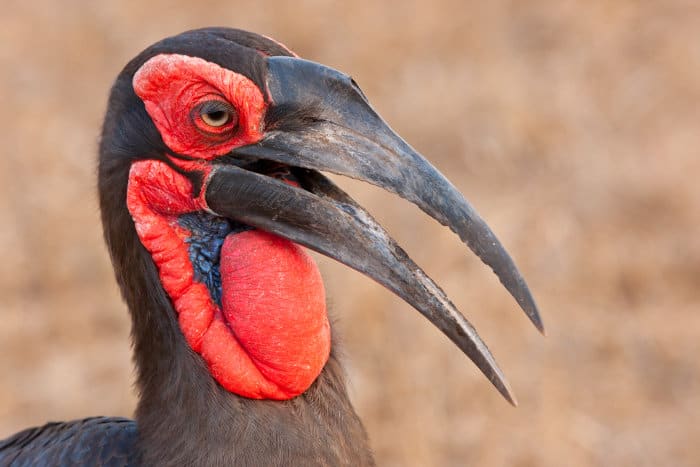
However, the birds only develop these colors as adults. In the first three years, the facial skin is gray or pale yellow, and the feathers are not quite black but rather dark brown.
Of course, the most striking feature of the bird is the titular hornbill. It’s an impressively thick, slightly curved piece designed for effective foraging and capturing prey.
The “horn” on top of the bill looks like an extra piece of beak attached. It’s actually a chamber that amplifies the sounds the hornbill makes — to great effect!
Try to get a look at a southern ground hornbill staring at you directly. You’ll notice its beautiful, almost hypnotic eyes, complete with eyelashes that would make a fashion model jealous.
The southern ground hornbill’s eyelashes are actually modified feathers that help protect their eyes from dust and sunlight.
Southern Ground Hornbill Habitat: Why It’s Called a ‘Southern’ Hornbill
We call them “southern” ground hornbills for a good reason, though you can spot them as far north as Kenya.
Typically, they roam more south — specifically among the African savannas and grasslands of Angola, Namibia, and South Africa.
They like a combination of short grass in which they can forage for food and tall trees for nesting and roosting.
In contrast, the Abyssinian ground hornbill, also known as the northern ground hornbill, is smaller and found north of the equator.
These birds are the second largest hornbill species and sport blue and red colorations on their necks.
They’re able to survive in drier, more arid landscapes than their southern counterparts but share many similar habits, like nesting in trees.
Essential Southern Ground Hornbill Facts
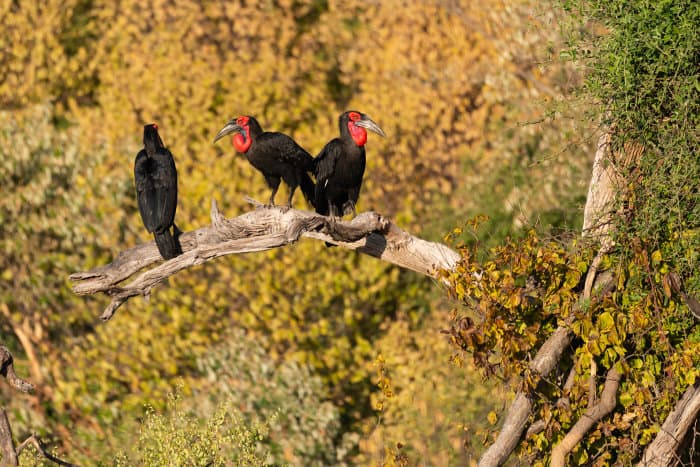
Now that we know what it looks like and where to find it, let’s take a look at some wild and wonderful facts about our hornbill’s social life, diet, and genetic family.
Hornbill social life
Would you believe that southern ground hornbills live in ‘families’ or groups?
Like a herd of grazers, hornbill bird flocks have a dominant pair. Roughly ten or even more birds accompany them, forming a family-like group.
This is where it gets interesting. The dominant pair will usually be the oldest or biggest and strongest birds. They will be the only pair to mate and are generally monogamous for their entire lives.
The other birds act as a sort of support structure. They will hunt, help take care of the young, and do much of the “work” of the flock.
Southern ground hornbill behavior
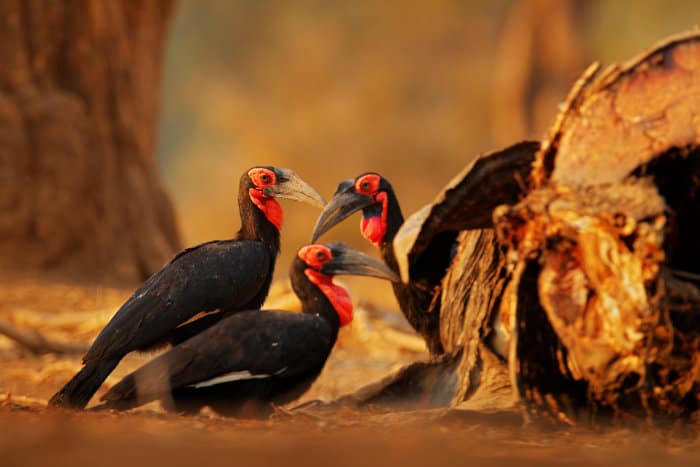
Despite this giant bird being able to fly, southern ground hornbills don’t migrate.
Instead, they occupy and protect territories in groups of between two and ten members. These territories are usually vast and can range between 50-250 square kilometers.
They’re most active during the day and tend to get going with territorial calls. They’ll spend their time walking about, slowly searching for food on the ground. The group will work together and gather around if they spot larger, more challenging prey, like snakes or hares.
These large birds can also be playful, with the young “attacking” each other with their large bills or pestering the older group members.
When night falls, southern ground hornbills roost up in trees. Group members typically share the same sleeping location.
Southern ground hornbill breeding is complicated
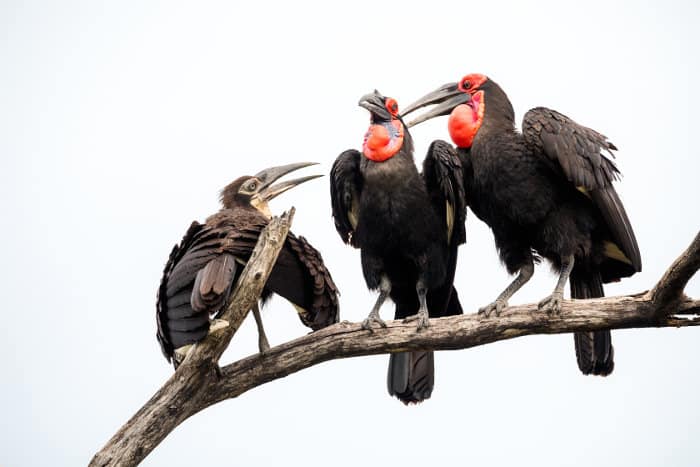
If the social setup of this hornbill sounds strange, the process of raising chicks is mind-blowing.
The southern ground hornbill is what is technically referred to as an “obligate cooperative breeder.” This means that to breed successfully, a mating pair uses the assistance of other birds to rear their chicks.
They require at least two “assistants”. Studies have shown that when these assistants are not present, adult hornbills often fail to breed successfully.
This also means that when hornbills are juveniles, they assist older pairs with rearing the young.
Even more bizarrely, studies have shown that hornbills who did not assist others with young are less likely to rear their own young.
Hornbills lay two or three eggs at a time, following around 45 days of incubation. They commonly make their nests in tree hollows above ground, padding them with dry grass and leaves.
Sadly, only one of the hatchlings — normally the oldest and strongest — survives, as it takes most of the food provided.
Parents will rear the surviving fledgling for around three months. After that, the young will still be dependent on the older birds for about two years.
A group of southern ground hornbills only produce and raise about one chick roughly every nine years.
They are one of the slowest reproducing groups in the bird kingdom, which makes them more vulnerable to extinction.
The southern ground hornbill lifespan: How long do they live (in the wild vs captivity)?
Ground hornbills can live a surprisingly long life.
Although infant mortality is high (up to 70%) and exact lifespan in the wild is not well recorded, it is estimated to be at least 30-40 years.
In captivity however, the lifespan figures for southern ground hornbills are almost double (up to 70 years).
Side fact: These African hornbills reach maturity around the age of six and are ready to breed from about 10 years old.
What do hornbills eat? The southern ground hornbill diet
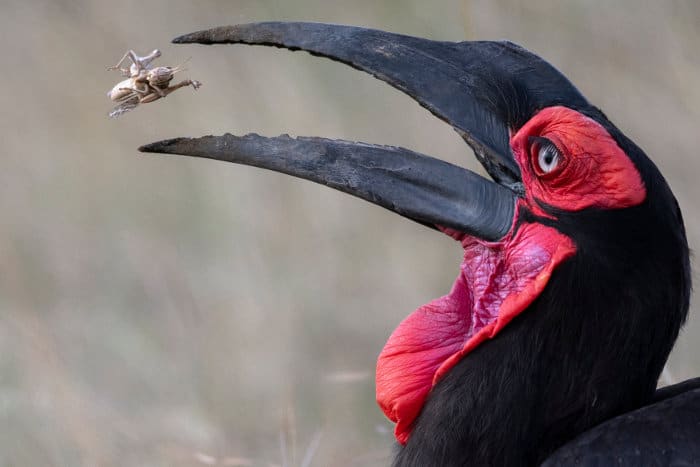
In the wild, southern ground hornbills are skilled foragers, much like baboons. Yes, they are carnivorous and will happily seek out all kinds of insects and small animals to eat.
You can also count various arthropods, snails, frogs, and some African snakes among their meals. Small rodents like hares and mice may also be on the menu.
Some say that hornbills aren’t fussy, really; anything they can eat, they will. Strangely, though, they hardly ever seem to drink water.
Ultimately their diet largely depends on where they are, what is in abundance, and whether they can overpower their prey.
It’s not uncommon to find groups of African ground hornbills in close proximity to troops of baboons or other animals. They often form feeding groups, going where the food is, so to speak.
In fact, scientists often look to hornbills as one key indicator of the health of a biome.
What are the predators of the southern ground hornbill?
There are a few enemies in the wild for our African southern ground hornbill.
If they are not paying attention, a ferocious martial eagle, a leopard, or a fast crocodile may go for them. Young individuals are also vulnerable to snakes.
Like so many of Africa’s beautiful creatures, the main threat to hornbills comes from human expansion, environmental poisoning, logging, and hunting.
These hornbills are often hunted by humans for traditional rituals and medicine, or killed for entering or damaging their property.
It’s a shame because hornbills are fairly harmless to humans.
The call of the southern ground hornbill
The southern ground hornbill call is quite blaring. It doesn’t care much about subtlety when it comes to noise.
For reasons we’re about to discuss, it uses around five different calls. Often, these calls are group choruses that can travel as far as 4 km away.
During mating season, the male’s red pouch inflates, allowing him to make a huge booming sound that can be mistaken for a lion’s roar! If you’re out in the field and you hear it, lock your doors, just to be sure. You don’t want to get this one wrong. 🙂
A grunting sound is most common when birds exert themselves in play or fighting. Younger birds and females also have a particular cry when feeding time arrives.
A more frenetic alarm sounds when there’s a predator nearby, and lastly, a territorial boom indicates a group’s presence.
These ground hornbill sounds have far-reaching repercussions, often signalling other hornbills several kilometers away.
Hornbills of South Africa: other names
If you’re traveling around Africa, rangers and locals may refer to the southern ground hornbill by another name, like the Bromvoël or iNsingizi bird. Here are a few of the most common variations:
- English: Southern ground hornbill
- Afrikaans: Bromvoël
- isiZulu: iNgududu/iNsingizi
- isiXhosa: Intsikizi
- Setswana: Lehututu
- Tshivenda: Dandila
- Xitsonga: Nghututu
- Sepedi: Mahutuhutu
Other Types of Hornbills in Southern Africa
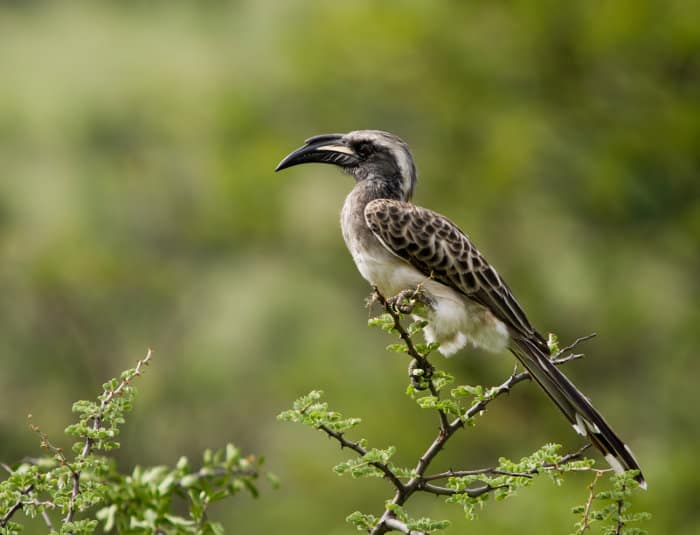
Several other varieties of hornbill live in the southern regions, especially in South Africa. All of them are smaller than the majestic southern ground, though all carry some form of the distinctive curved beak.
- African grey hornbill (Lophoceros nasutus)
- Trumpeter hornbill (Bycanistes bucinator)
- Crowned hornbill (Lophoceros alboterminatus)
- Southern yellow-billed hornbill (Tockus leucomelas)
- Southern red-billed hornbill (Tockus rufirostris)
African Ground Hornbill: Conservation and Challenges Ahead
Because the hornbill reproduces so slowly, its numbers have declined somewhat rapidly over the past few decades. Many countries have listed this species as vulnerable or endangered.
Fortunately, conservation efforts are underway, with organizations like the Mabula Ground Hornbill Project playing a leading role in protecting these beautiful birds.
Some of the most successful conservation strategies thus far have been to provide artificial nests, as their breeding grounds are often damaged or inadequate.
An alternative strategy is to harvest and rear the additional chicks that would otherwise die of starvation. Once the chicks are artificially reared, the rewilding process can begin, and environmentalists can reintroduce them into nature to reproduce further.
Along with these conservation plans, there are regional educational and awareness programs to teach people the importance of protecting these precious birds.
Hopefully, Not the Last Word on Southern Ground Hornbills

This giant hornbill is a fascinating and undeniably beautiful bird. Who can resist those soulful eyes? Or that beautiful beak, and a voice that booms like a lion’s roar?
It would be a shame to no longer have the southern ground hornbill among us, if only to observe their unique family life and bizarre breeding strategy.
So next time you’re on an African safari, make a point of enquiring with the ranger about the biggest hornbill of them all – our gorgeous southern ground hornbill!

